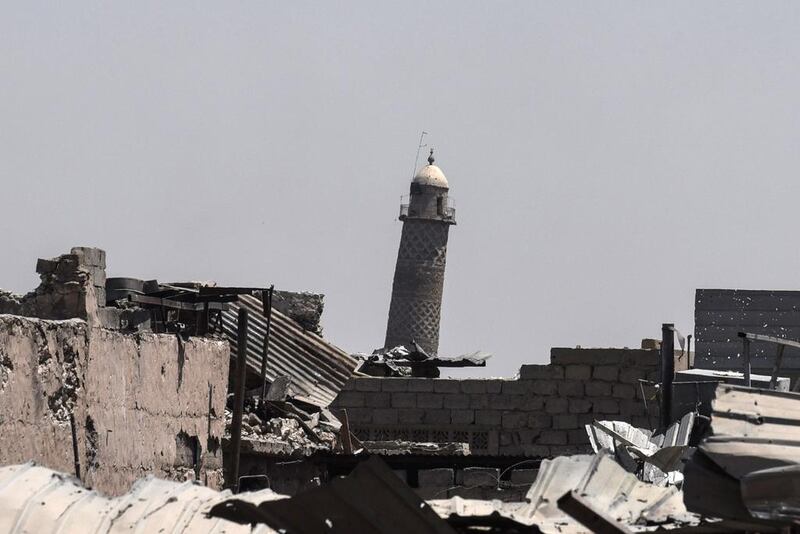MOSUL // The Iraqi military said on Wednesday it had begun a push towards the historic mosque in Mosul’s Old City, where ISIL is mounting a brutal last stand in a labyrinthe of narrow lanes and booby-trapped houses.
Iraqi Special Operations Forces were 200 to 300 metres away from the medieval Grand Al Nuri Mosque, where ISIL leader Abu Bakr Al Baghdadi declared the group’s self-styled “caliphate” in 2014, the military said.
On Sunday, in the final stage of a battle for Mosul that has entered its ninth month, Iraqi special forces, the army and paramilitary police units began inching into the city’s historic core on the west bank of the Tigris river.
With many streets too narrow for vehicles to pass through, soldiers are mostly advancing on foot and a top general admitted to The National that fighting will be tough and prolonged.
ISIL is thought to have hundreds of fighters left to defend around a square mile of territory, and is holding thousands of civilians hostage as human shields.
“I can’t tell you how long [the final stage of the battle] will take,” said Lieutenant Geneneral Abdul Ghani Al Asadi, the field commander of the Iraqi Special Operations Forces, or ISOF, that are attacking on the western front. “The advance will be slow because of the civilians and the difficulties of fighting in the Old City.”
“Daesh are cornered and cannot run. They have to options, to die or to surrender,” he added.
Military intelligence suggests that around 800 militants are still fighting in Mosul, according to Major Hishar, an officer with Iraq’s 15th Division. Of these, 300 are thought to be foreigners, who have a reputation as skilled and fanatical fighters. If these numbers are accurate, then ISIL is able to defend the Old City with far greater manpower than it deployed in other areas of Mosul, though other military estimates have put the total number of remaining ISIL fighters at just 300.
As ISOF advances on ISIL positions on a broad front from the west, the regular army is cautiously moving in from the north, and the paramilitary Federal Police is attacking from the south. Commanders on the ground say that progress has been slowed by improvised explosive devices planted by the extremists, who have also deployed poison gas to stem the Iraqi advance.
On Sunday, two ISOF soldiers suffering from the effects of a gas attack arrived at a coalition field hospital near Mosul, according to Major Khalid, an ISOF medical officer.
The next day, Salam Sreir, another ISOF soldier, arrived at the same hospital with a bandage wrapped around his right forearm. He had come into contact with gas the previous day when his unit discovered an ISIL weapons cache in the recently liberated Thawra neighbourhood, next to the Old City.
“We found a stash of homemade RPGs [rocket propelled grenades] in a house, and I helped move them. When I picked one up I noticed a strange smell. A few hours later, the skin of my arm started bubbling up, and I was in pain,” said Mr Sreir.
The extremists have made increasing use of chemical weapons since the fighting shifted to north-west Mosul in April, prompting the Iraqi military to issue gas masks to its men fighting in the city.
So far, ISIL has delivered poison gas in mortar rounds or crude bombs with fuses that are lit by the militants before they make a quick getaway. ISIL have now expanded the range of delivery to RPGs, short-range rockets used against vehicles or infantry.
Mr Sreir was told to strip off the black uniform of the elite forces next to the blast walls of the field hospital, and given a soapy liquid to wash his arms. When the bandage was removed, large blisters became visible. Australian medical staff in gas masks then hosed him down before leading him into a tent for further treatment while his uniform was discarded in a plastic bag.
After a while he emerged, clad in an ill-fitting tracksuit and holding a medical note. On the piece of paper, a medic had jotted down the cause of his injury in big, bold letters: “Mustard gas.”
foreign.desk@thenational.ae
* With additional reporting by Reuters





